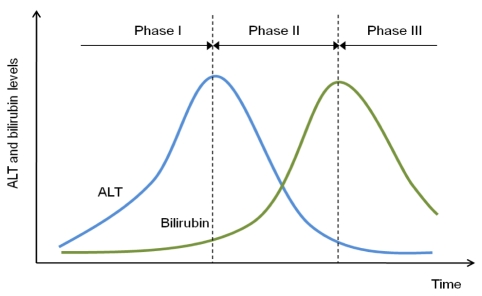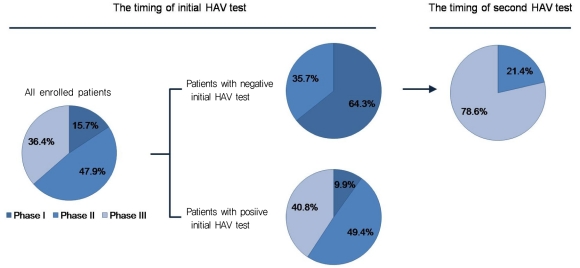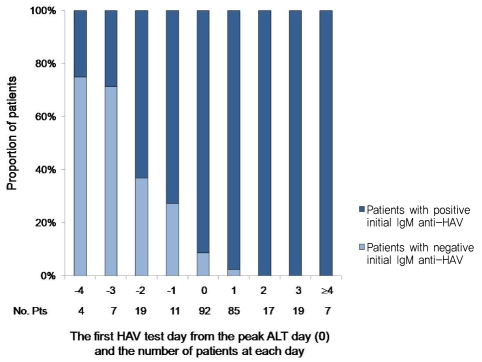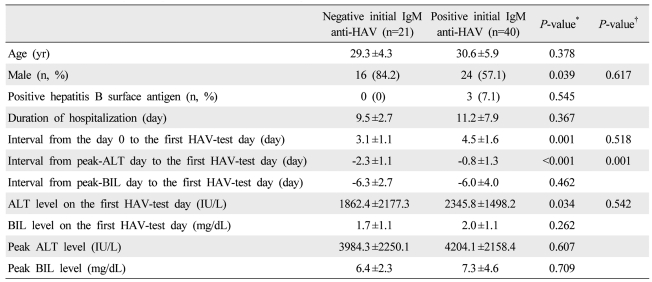1. Kang HM, Jeong SH, Kim JW, Lee D, Choi CK, Park YS, et al. Recent etiology and clinical features of acute viral hepatitis in a single center of Korea. Korean J Hepatol 2007;13:495-502. 18159147.


2. Mun JS, Kim HJ, Hue C, Kim SJ, Moon HJ, Lee HW, et al. The etiology of acute viral hepatitis for the last 3 years at a single institution in Seoul. Korean J Med 2008;74:624-631.
3. Sjogren MH, Cheatham JG. In: Feldman M, Friedman LS, Brandt LJ, eds. Hepatitis A. Sleisenger and Fordtran's Gastrointestinal and Liver Disease. 2010. 9th ed. Philadelphia PA: Saunders Elsevier; p. 1279-1285.

4. Lemon SM. Type A viral hepatitis: epidemiology, diagnosis, and prevention. Clin Chem 1997;43:1494-1499. 9265900.


5. Liaw YF, Yang CY, Chu CM, Huang MJ. Appearance and persistence of hepatitis A IgM antibody in acute clinical hepatitis A observed in an outbreak. Infection 1986;14:156-158. 3759243.


6. Kao HW, Ashcavai M, Redeker AG. The persistence of hepatitis A IgM antibody after acute clinical hepatitis A. Hepatology 1984;4:933-936. 6090293.


7. Lee EJ, Kwon SY, Seo TH, Yun HS, Cho HS, Kim BK, et al. Clinical features of acute hepatitis A in recent two years. Korean J Gastroenterol 2008;52:298-303. 19077476.

8. Shin HP, Lee JI, Jung SW, Cha JM, Joo KR, Kang SY. Factors for predicting positive results for anti-HAV IgM retesting among initially seronegative patients. Dig Dis Sci 2010;55:3537-3540. 20108041.


9. Sherlock S, Dooley J. In: Sherlock S, Dooley J, eds. Viral hepatitis: general features, hepatitis A, hepatitis E and other viruses. Deases of the Liver and Biliary System. 2002. 11th ed. Oxford: Blackwell Science; p. 267-283.

10. Oren R, Shouval D, Tur-Kaspa R. Detection of hepatitis A virus RNA in serum from patients with acute hepatitis. J Med Virol 1989;28:261-263. 2550586.


11. Yotsuyanagi H, Iino S, Koike K, Yasuda K, Hino K, Kurokawa K. Duration of viremia in human hepatitis A viral infection as determined by polymerase chain reaction. J Med Virol 1993;40:35-38. 8390558.


12. Jung YM, Park SJ, Kim JS, Jang JH, Lee SH, Kim JW, et al. Atypical manifestations of hepatitis A infection: a prospective, multicenter study in Korea. J Med Virol 2010;82:1318-1326. 20572083.


13. Yoon YK, Chun BC, Lee HK, Seo YS, Shin JH, Hong YS, et al. Epidemiological and genetic analysis of a sustained community-wide outbreak of hepatitis A in the Republic of Korea, 2008: a hospital-based case-control study. J Clin Virol 2009;46:184-188. 19665426.











 PDF Links
PDF Links PubReader
PubReader ePub Link
ePub Link Full text via DOI
Full text via DOI Download Citation
Download Citation Print
Print




